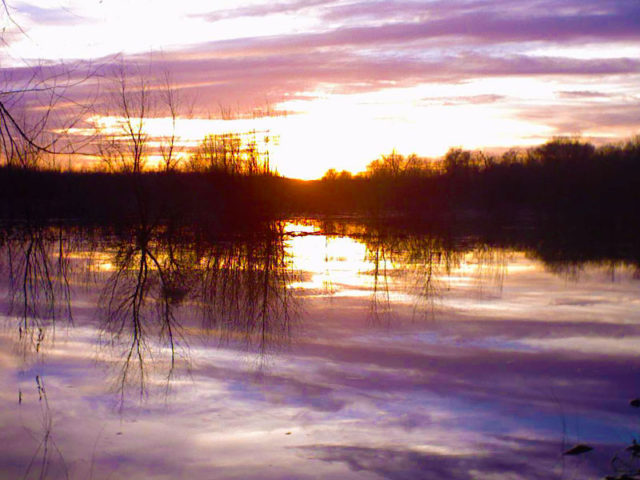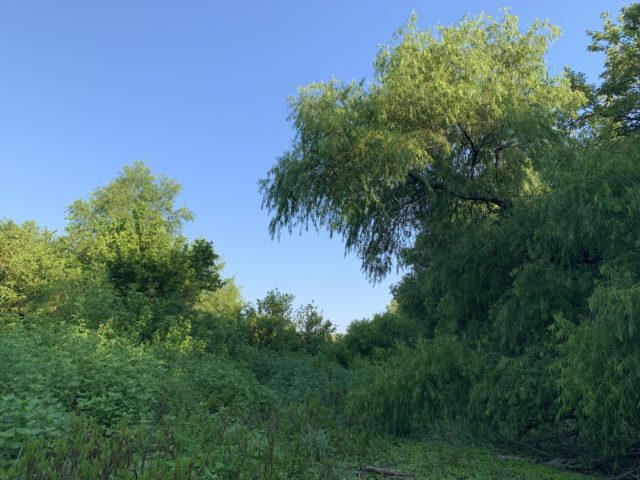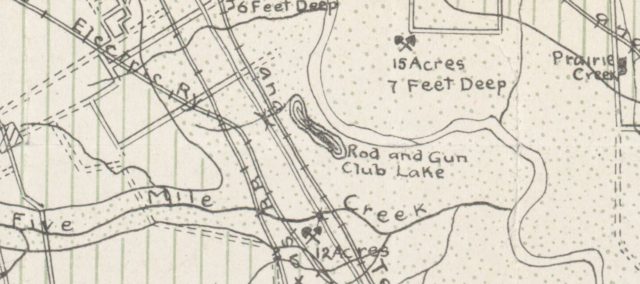I first discovered Lemmon Lake early one morning in the Summer of 2012. Glimpses of the deep blue water could be seen through breaks in the tangled woods as I made my way along the newly laid Trinity Forest Trail. The wide concrete path followed a route that hugged the west side of the lake, never meandering more than a few yards from the water’s edge. But because of the impossibly thick foliage growing up around the margin–which blocked both view and access–the lake was so unreachable that it might as well have been on another planet.
I had heard many stories about the unique wildlife that could be found here–animals living at Lemmon Lake in relative abundance that were rare to be seen anywhere else in the metroplex. I stood on the concrete trail for a moment trying hard to see through the interlocked Black Willow branches. These sidelong looks at the lake had me immediately intrigued. Here was the promise of an environment unlike anything else I had found in North Texas. Behind those trees–if the rumors I had heard were true–was the most important ecosystem in all of Dallas County. I made plans to return just as soon as I possibly could.
A few days later I was back, and this time I wasn’t going to be satisfied with fleeting glimpses. This time I intended to push my way into the woods and not stop until I was standing on the shores of this enigmatic lake. In I went through thick groves of privet, and large, sticky orb-weaver spider webs. Along the way I carefully skirted touchy skunks, and more than one slithering snake. When I finally emerged on the other side I stood before acres and acres of placid lake water completely surrounded by a mighty fortress of lush green forest. An urban wildlife Shangri-la just a few miles from downtown Dallas.

Why Lemmon Lake is Special
The shallow waters of Lemmon Lake combine with the isolating effect of its perimeter of trees and dense underbrush to create a uniquely vibrant habitat. The nutrient rich lake water make this an ecosystem attractive to nearly every type of unusual and exotic wildlife that can be found in North Texas. The place abounds with life.
Curved billed ibises feed just off the reed beds. Unexpected and vividly pink-colored birds with odd, spoon-shaped bills soar through the air. Long-necked whistling ducks huddle just off shore. Prominently billed storks keep watch on the river from the treetops. Small tuxedoed birds on stilted legs wade through the shallows. Egrets and herons move up and down the lake by the hundreds. Pileated Woodpeckers scream their jungle call as they zoom from one side of the lake to the other. Hundreds of huge, white pelicans–each with 9-foot wingspans–stop here to rest on their seasonal migrations. Crested Caracara make surprise appearances. River Otters dive and tumble in the deeper channels near the dam. Coyotes patrol the tall grass and reeds just off shore. Sounders of wild boar wade through the shallows rooting for tubers. White-tailed Deer vanish into the shadowy woods. Raccoons gorge on an endless supply of crayfish and sleep it off in the crotches of the tallest trees. Reptiles and amphibians of every imaginable type hide in the muck.
Gone Forever?
But Lemmon Lake may be no more. As evidenced by imagery found on Google Earth, the dam between the lake and the Trinity River breached sometime in the middle of 2017. When the dam failed, a hole was ripped open that drains the lake directly and immediately into the river. Lemmon Lake has not held water for an appreciable time since. Without restoration of the levee, the lake may never hold water again, forever altering this one-of-a-kind wilderness area.
Cycles of Renewal
One of the more interesting things about Lemmon Lake is the way that it is in a near constant state of flux. Cyclical and seasonal changes regularly reconfigure the lake in dramatic ways.
I returned on an almost weekly basis that first summer at Lemmon Lake. Each time I visited, I was struck by how different things were from just the week before. The water in this shallow lake would retreat yards a day under the pressure of evaporation caused by the intense summer heat. In just a few weeks the entirety of the water was gone, leaving an expansive mud flat in its place.
Next came the new plant growth as silt-loving vegetation began to spring up in the rich soil of the baked lake bed. Soon the entire area would be covered in chest-high grass and weeds.
Over the fall and winter the plant life would die off, their remains becoming part of the peat of the lake bed. And with the coming of spring rains, Lemmon Lake would refill making a nutrient rich soup of the silt left behind from the summer’s plant growth.
Footage shows the dry lake bed transforming with vegetation growth,
and one major refilling event
It turns out this drying and refilling has been something of an annual event at Lemmon Lake. At some point in the lake’s history the creeks that fed it were cut off by development. Once that happened the yearly drying became almost inevitable. From that point on, refilling the lake would require the adjacent Trinity River to over-bank. And that would only happen with intense rainstorms lingering for extended periods over just the right parts of North Texas.
Over the decades this cycle of flooding by the mighty Trinity River gnawed away at the Lemmon Lake dam. During that first summer, I discovered a place where the dam was just barely hanging on. A mere sliver of the levee remained, still a full 15 feet above the river, but only 3 feet wide at the top. A careful balancing act was required to cross the weakened dam as our party made its way through the wilderness between the lake and river. This tenuous structure was all that separated the two bodies of water, and it was easy to see that it would not last much longer.
Spending time at Lemmon Lake is tasking. It is not an easy place to visit–especially in the summer, when high temperatures, venomous reptiles, and tangled vegetation make exploring especially treacherous. These days, I only stop by for special and well planned occasions. But I have remained fascinated with the lake, and I always keep my ear to the ground for news.
When I noticed on Google Earth that the dam had breached, I became determined to see it up close and personal. As expected, reaching the collapsed levee was not easy. But it was well worth the effort, as these pictures reveal…

Click to Enlarge
Going forward, Lemmon Lake will certainly still refill from time to time with each Trinity River flood event. But the lake will only stay full as long as the river level is high enough to support it. As the river recedes, it will take the lake’s water with it, drawing it out through this gaping hole in the dam. Without repair, Lemmon Lake may never hold water for any extended period of time again–forever changing this imminently unique North Texas habitat.
History
The history of Lemmon Lake is difficult to pin down. Good information about the lake is scarce and difficult to come by. Scouring the internet, I found this Dallas County map from 1918. It shows Lemmon Lake on a plot of property belonging to a private hunting and fishing club. This bit of evidence sets the age of the lake at well over 100 years.
The modern history of Lemmon Lake could be considered to have begun around 1986 when Dallas County purchased the property, and then leased it to the City of Dallas for maintenance. The intent was to create a park in south Dallas comparable to White Rock Lake or Bachmann Lake in the north. The two videos below are local news reports describing the ambitious project…
Notable in these two videos is what they reveal about the condition of Lemmon Lake at the time. The lake water in 1986 covered much more area at capacity than it does now. Except for a few large trees, the dam was virtually clear of vegetation, allowing for a gravel road along the top which followed its entire length.
There were still clear views of the water from the utility right of way dividing Lemmon Lake from Little Lemmon Lake. In 1986 water lapped the ROW as its northern shore.
Lemmon Lake does not look this way any longer. Silt accumulation and unrestricted vegetation growth has changed the character of the lake in major ways. The dam is now completely covered under a layer of dense vegetation, its pathway long since obliterated in most places. Exposed rip-rap consisting of demolition debris is visible along most of its length.

Click to Enlarge
Whole forests have grown up longitudinally down the center of the lake as a peninsula of silt collected over the years. By 2001 the north end of the lake had clogged with vegetation and stopped holding water for much the same reason.
The grand plans to turn Lemmon Lake into a recreational destination for Dallasites never really came to fruition, in spite of some improvements to the property being made… A small, out-of-the-way park was installed on the north west end of the lake shortly after the property was purchased by the county. In 2009 the Trinity Forest Trail was laid down running from the north side of the Joppa Preserve down to the Eco Park building in the south.
In spite if these additions, Lemmon Lake did not become the haven for park visitors envisioned in those 1986 news reports. Meanwhile, the park was neglected, and the state of the lake deteriorated steadily.

The map below suggests that at some point an analysis was done on the condition of the lake and some loose recommendations were made. At the time that this map was produced, it appears that the need to shore up the dam in certain places between the lake and the river was well recognized. Note the labels calling for levee realignments…
The End?
The ultimate fate of Lemmon Lake is not clear. It is unlikely that anyone in a position of authority knows about this situation. Once made aware, it is unclear if anyone will be interested in addressing it.
Repairs may be possible, but they will certainly be disruptive to the delicate ecosystem at Lemmon Lake. Even so, with the lake currently absent water, now may a good time to give it a go. A few earth-movers could likely resolve many of the issues without the need for specialized heavy equipment. Whether repairs should be pursued is another question altogether.
If restoration of Lemmon Lake is attempted, clearing the lake bed of trees and other vegetation would be the obvious place to start. Brush piles could be left behind as habitat for fish and other wildlife for after the lake refills.
Accumulated silt could be removed and relocated to patch and realign the levees per recommendations. Creating a reinforced spillway to allow controlled outflow drainage back into the river when the lake overfills might also be needed, and would likely be the most expensive and engineering intensive improvement.
Qualified oversight of the effort would be of paramount importance. Care would be required to ensure the restored lake retained as much of its original character as possible. The goal would be to ensure that the special and unique wildlife endemic to the Joppa Preserve continues to return.
If the dam is repaired, the lake may be restored to a condition similar to that of its early days. If it is left as is, it will continue to transform into a different type of habitat–maybe for the better, or maybe for the worse–but undeniably changed from the Lemmon Lake I have come to know.


















I haven’t been down there since 2004 and it was like that then. I would think the city might repair it but they are broke and the crime in that area is very high and I don’t ever see it happening. Notable think about the lake it was on the Bonnie and Clyde movie in the early 60s where the sheriff gets thrown off into the lake.
My father had a membership at J.J. Lemmon lake late 50’s to mid-60’s, $100 yearly. We would leave Dowdy Ferry Rd., hit Loop 12 going SWest, take 310 (Central Expressway) a short distance South, left on River Oaks, cross the rail road tracks and we were there to go fishing. There was a chemical plant at the RR tracks, maybe Dow. Boat docks were on the South bank of the lake, and Mr. Lemmon had a clubhouse on the left going to the docks. Met him several times. Dad had two trotlines in the southeast end of the lake, and we would pull out mostly crappie, but also catfish, some bass, occasionally an eel. Lost his wallet one Friday night in the lake after cashing his check and we had to live on his old coin collection the following week. Boy Scout Troop 109 had an overnight campout Spring 1966 at the Five Mile Creek entry to the lake. Was thinking of making a trip to check out Lemmon Lake until I learned of its sad demise by losing its water to the river.
EDITOR’S NOTE: What a great comment! Thank you for sharing this with us!
A sad Epitaph For my grandfather j j lemmon Who built and loved this place so much. As a young boy I spent summers there. At that time there were 2 clubhouses and A boat house.. Now only memories. I hope someone will take an interest and restore it.